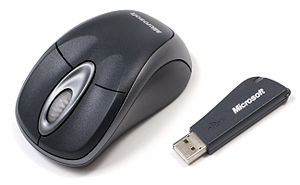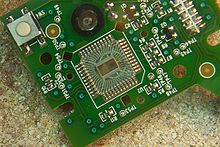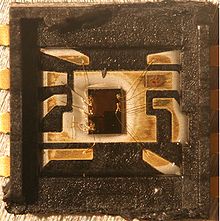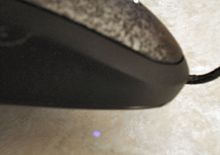- Optical mouse
-
An optical computer mouse or "optic mouse" uses a light-emitting diode and photodiodes to detect movement relative to a surface, unlike a mechanical mouse which has a ball which rotates orthogonal shafts which drive chopper wheels for distance measurement.
Contents
Early optical mice
Early optical mice, first demonstrated by two independent inventors in 1980, came in two different varieties:[1][2][3]
Some, such as those invented by Steve Kirsch of MIT and Mouse Systems Corporation,[4][5] used an infrared LED and a four-quadrant infrared sensor to detect grid lines printed with infrared absorbing ink on a special metallic surface. Predictive algorithms in the CPU of the mouse calculated the speed and direction over the grid.
Others, invented by Richard F. Lyon and sold by Xerox, used a 16-pixel visible-light image sensor with integrated motion detection on the same chip[6][7] and tracked the motion of light dots in a dark field of a printed paper or similar mouse pad.[8]
These two mouse types had very different behaviors, as the Kirsch mouse used an x-y coordinate system embedded in the pad, and would not work correctly when the pad was rotated, while the Lyon mouse used the x-y coordinate system of the mouse body, as mechanical mice do.
Modern optical mice
Modern surface-independent optical mice work by using an optoelectronic sensor (essentially, a tiny low-resolution video camera) to take successive images of the surface on which the mouse operates. As computing power grew cheaper, it became possible to embed more powerful special-purpose image-processing chips in the mouse itself. This advance enabled the mouse to detect relative motion on a wide variety of surfaces, translating the movement of the mouse into the movement of the cursor and eliminating the need for a special mouse-pad.
The first commercially successful optical computer mouse was the Microsoft IntelliMouse® with IntelliEye™, introduced in 1999 using technology developed by Hewlett-Packard.[9] It worked on almost any surface, and represented a welcome improvement over mechanical mice, which would pick up dirt, track capriciously, invite rough handling, and need to be taken apart and cleaned. Instead the reliable performance of the IntelliMouse® allowed relaxed grips which also were less likely to cause repetitive strain injury. Other manufacturers soon followed Microsoft’s lead using components manufactured by the HP spin-off Agilent Technologies, and over the next several years mechanical mice became obsolete.
The technology underlying the modern optical computer mouse is known as digital image correlation, a technology pioneered by the defense industry for tracking military targets. Optical mice use image sensors to image naturally occurring texture in materials such as wood, cloth, mouse pads and Formica. These surfaces, when lit at a grazing angle by a light emitting diode, cast distinct shadows that resemble a hilly terrain lit at sunset. Images of these surfaces are captured in continuous succession and compared with each other to determine how far the mouse has moved.
To understand how optical mice work, imagine two photographs of the same object except slightly offset from each other. Place both photographs on a light table to make them transparent, and slide one across the other until their images line up. The amount that the edges of one photograph overhang the other represents the offset between the images, and in the case of an optical computer mouse the distance it has moved.
Optical mice capture one thousand successive images or more per second. Depending on how fast the mouse is moving, each image will be offset from the previous one by a fraction of a pixel or as many as several pixels. Optical mice mathematically process these images using cross correlation to calculate how much each successive image is offset from the previous one.
An optical mouse might use an image sensor having an 18 x 18 pixel array of monochromatic pixels. Its sensor would normally share the same ASIC as that used for storing and processing the images. One refinement would be accelerating the correlation process by using information from previous motions, and another refinement would be preventing deadbands when moving slowly by adding interpolation or frame-skipping.
The invention of the modern optical mouse at HP was made more likely by a succession of related projects during the 1990s at its central research laboratory. In 1992 John Ertel, William Holland, Kent Vincent, Rueiming Jamp and Richard Baldwin were awarded US Patent 5,149,980 for measuring paper advance in a printer by correlating images of paper fibers. In 1998 Travis N. Blalock, Richard A. Baumgartner, Thomas Hornak, and Mark T. Smith were awarded US Patent 5,729,008 for tracking motion in a hand-held scanner by correlating images of paper fibers and document features, a technology commercialized in 1998 with the HP 920 Capshare handheld scanner. In 2002 Gary Gordon, Derek Knee, Rajeev Badyal and Jason Hartlove were awarded US Patent 6,433,780 for the modern optical computer mouse using image correlation.
Laser mice
The laser mouse uses an infrared laser diode instead of a LED to illuminate the surface beneath their sensor. As early as 1998, Sun Microsystems provided a laser mouse with their Sun SPARCstation servers and workstations.[10] However, laser mice did not enter the mainstream market until 2004, when Paul Machin at Logitech, in partnership with Agilent Technologies, introduced its MX 1000 laser mouse.[11] This mouse uses a small infrared laser instead of a LED and has significantly increased the resolution of the image taken by the mouse. The laser enables around 20 times more surface tracking power to the surface features used for navigation compared to conventional optical mice[citation needed].
Glass laser (or glaser) mice have the same capability of a laser mouse but can also be used on top of mirror or transparent glass with few problems.[12]
In August 2009, Logitech introduced mice with two lasers, to track on glass and glossy surfaces better; they dubbed them "dark field" mice.[13]
LED color
The color of the optical mouse's light-emitting diodes can vary, but red is most common, as red diodes are inexpensive and silicon photodetectors are very sensitive to red light.[14] Other colors are sometimes used, such as the blue LED of the V-Mouse VM-101 illustrated at right.
Power
Manufacturers often engineer their optical mice—especially battery-powered wireless models—to save power when possible. In order to do this, the mouse dims or blinks the laser or LED when in standby mode (each mouse has a different standby time). A typical implementation (by Logitech) has four power states, where the sensor is pulsed at different rates per second:
- 11500: full on, for accurate response while moving, illumination appears bright.
- 1100: fallback active condition while not moving, illumination appears dull.
- 110: standby
- 12: sleep state
Movement can be detected in any of these states; some mice turn the sensor fully off in the sleep state, requiring a button click to wake.
Optical mice utilizing infrared elements (LEDs or lasers) offer substantial increases in battery life[citation needed]. Some mice, such as the Logitech V450 848 nm laser mouse, are capable of functioning on two AA batteries for a full year, due to the low power requirements of the infrared laser[clarification needed].
Mice designed for use where low latency and high responsiveness are important, such as in playing computer games, may omit power-saving features to improve performance[15].
Optical versus mechanical mice
Unlike mechanical mice, which can become clogged with lint, optical mice have no moving parts; therefore, they do not require maintenance other than removing debris that might collect under the light emitter. However, they generally cannot track on glossy and transparent surfaces, including some mouse-pads, sometimes causing the cursor to drift unpredictably during operation. Mice with less image-processing power also have problems tracking fast movement, though some mice can track faster than 2 m/s (80 inches per second).
Some models of laser mouse can track on glossy and transparent surfaces, and have a much higher sensitivity than other mechanical or optical mice, but are more expensive than their LED-based or mechanical counterparts.
As of 2006[update] mechanical mice had lower average power requirements than their optical counterparts; the power used by mice is relatively small, and only an important consideration when the power is derived from batteries, with their limited capacity.
Optical models outperform mechanical mice on uneven, slick, soft, sticky, or loose surfaces, and generally in mobile situations lacking mouse pads. Because optical mice render movement based on an image which the LED (or infrared diode) illuminates, use with multicolored mouse pads may result in unreliable performance; however, laser mice do not suffer these problems and will track on such surfaces. The advent of affordable high-speed, low-resolution cameras and the integrated logic in optical mice provides an ideal laboratory for experimentation on next-generation input-devices.[original research?] Experimenters can obtain low-cost components simply by taking apart a working mouse and changing the optics or by writing new software.
References
- ^ John Markoff (May 10, 1982). "Computer mice are scurrying out of R&D labs". InfoWorld 4 (18): 10–11. ISSN 0199-6649. http://books.google.com/books?id=bDAEAAAAMBAJ&pg=PA11&dq=optical-mouse+kirsch+lyon&lr=&num=20&as_brr=3&ei=TLI2S4_TG4rSkwTjy5DMAQ&cd=1#v=onepage&q=optical-mouse%20kirsch%20lyon&f=false.
- ^ John Markoff (February 21, 1983). "In Focus: The Mouse that Rolled". InfoWorld (InfoWorld Media Group, Inc.) 5 (8): 28. ISSN 0199-6649. http://books.google.com/books?id=-S8EAAAAMBAJ&pg=PA28&dq=optical-mouse+led+color&lr=&num=20&as_brr=3&ei=bK42S8jnO5qIlQSZuLy5AQ&cd=15#v=onepage&q=optical-mouse%20led%20color&f=false.
- ^ Sol Sherr (1988). Input Devices. Academic Press. ISSN 0126399700. http://books.google.com/books?lr=&as_brr=0&id=A1Z5AAAAIAAJ&dq=xerox+%22optical+mouse%22&q=xerox+lyon+kirsch&pgis=1#search_anchor.
- ^ Liz Karagianis (Fall 1997). "Steve Kirsch". MIT Spectrum. http://spectrum.mit.edu/issue/fall-1997/steve-kirsch/.
- ^ Retrieved 31 December 2006 "Portraits of MIT-Related Companies: Infoseek, Santa Clara, CA". MIT: The Impact of Innovation. MIT. http://web.mit.edu/newsoffice/founders/Infoseek.html Retrieved 31 December 2006.
- ^ Richard F. Lyon (1981). "The Optical Mouse, and an Architectural Methodology for Smart Digital Sensors". In H. T. Kung, Robert F. Sproull, and Guy L. Steele. VLSI Systems and Computations. Computer Science Press. http://books.google.com/books?id=t15TAAAAMAAJ&q=optical-mouse+lyon&dq=optical-mouse+lyon&lr=&as_brr=0&as_pt=ALLTYPES&ei=AKf7Sc3PLJDmkASaxq3LBA&pgis=1.
- ^ Stan Augarten (1983). State of the Art: A Photographic History of the Integrated Circuit. Ticknor & Fields. pp. 60–61. ISBN 0-89919-195-9. http://smithsonianchips.si.edu/augarten/i60.htm.
- ^ "Retrieved 31 December 2006". Digibarn.com. http://www.digibarn.com/collections/devices/xerox-mousepad/index.html. Retrieved 2010-05-29.
- ^ "Microsoft Press Release, April 19th 1999". Microsoft. 1999-04-19. http://www.microsoft.com/presspass/press/1999/apr99/eyepr.mspx. Retrieved 2011-05-11.
- ^ Computer Engineering Tips - Mouse. Retrieved 31 December 2006.
- ^ Logitech - MX1000 Laser Cordless Mouse[dead link]
- ^ "Comparison of optical, laser, and glass laser mouse.". http://support.a4tech.com/images/products/Accessary/x6-005D-2b.gif. Retrieved 2010-05-29.
- ^ Iain Thomson (August 21, 2009). "New Logitech mice operate wherever". PC Authority. http://www.pcauthority.com.au/News/153614,new-logitech-mice-operate-wherever.aspx.
- ^ Winn L. Rosch (2003). Winn L. Rosch hardware bible (6th ed.). Que Publishing. p. 756. ISBN 9780789728593. http://books.google.com/books?id=S90OaKQ-IzMC&pg=PA756&dq=optical-mouse+light-emitting-diode+red&lr=&num=20&as_brr=3&ei=0K42S4SnF47okwS10K2mAQ&cd=1#v=onepage&q=optical-mouse%20light-emitting-diode%20red&f=false.
- ^ Examples of mice which sacrifice power-saving in favour of performance are the Logitech G5 and the Razer Copperhead
Basic computer components Input devices Keyboard · Image scanner · Microphone · Pointing device (Graphics tablet · Joystick · Light pen · Mouse · Touchpad · Touchscreen · Trackball) · Webcam (Softcam)Output devices Removable data storage Computer case Central processing unit (CPU) · Hard disk / Solid-state drive · Motherboard · Network interface controller · Power supply · Random-access memory (RAM) · Sound card · Video cardData ports Ethernet · Firewire (IEEE 1394) · Parallel port · Serial port · Thunderbolt · Universal Serial Bus (USB)Categories:- Pointing devices
- Computing input devices
- History of human–computer interaction
- Video game control methods
- American inventions
Wikimedia Foundation. 2010.







